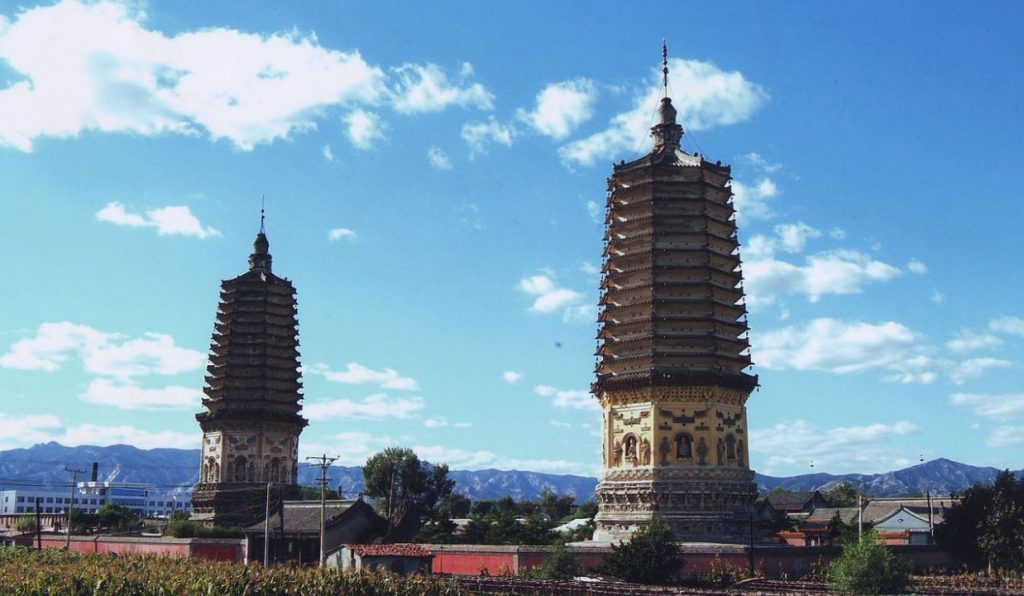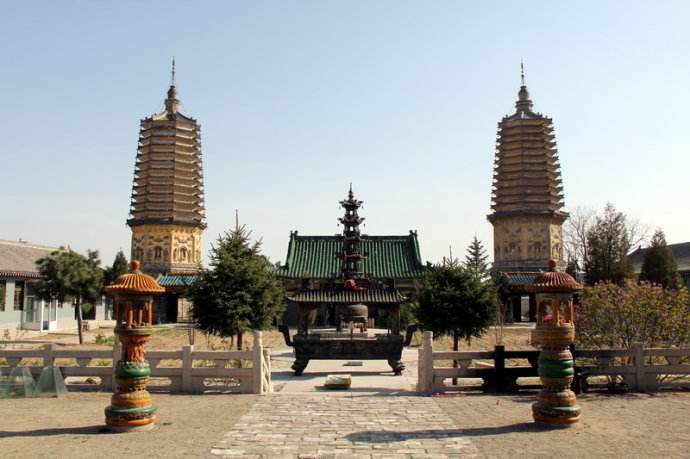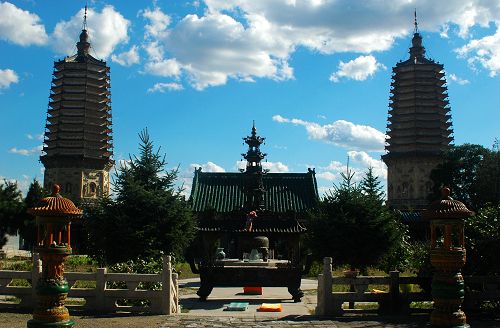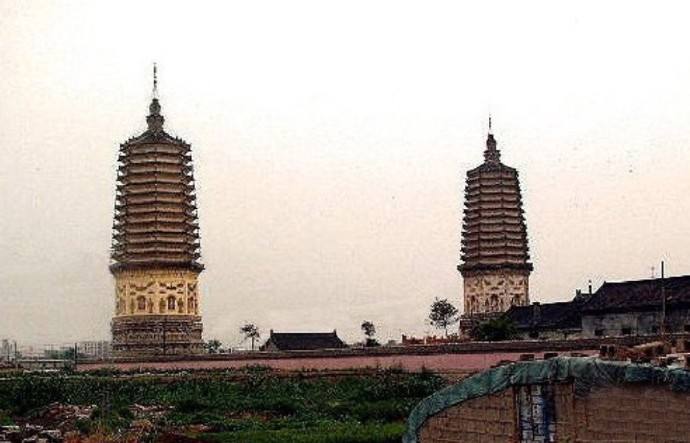Chongxing Temple Twin Pagodas
6 min readChongxing Temple Twin Pagodas of Jinzhou, Liaoning is the earliest juxtaposed twin pagodas extant in China. It is also a representative multieave-style pagodas in the Liao and Jin dynasties.

Chongxing Temple Twin Pagodas get the name because they are located in front od Chongxing Temple. The two pagodas stand 43 meters away at the east and west. The eastern pagoda is 43.85 meters high while the western one is 42.63 meters high.
These solid brick and stone pagodas have 13 layers of eaves separately. Octagonal in cross sections, they are almost the same in structure and construction.
The base of the pagoda is made of brick. Granite is covered outside to make it steadier in order to protect the body during the period of Emperor Guangxu in the Qing dynasty(1875-1908). The cross section of its body is in the shape of regularoctagon, each line of which is 7.3 meters long. The base is 3 meters high, covering an area of 257.3 square meters. The entire base consists of two layers: the upper layer is a throne carved in the shape of a huge lotus and the lower one is a reversed-lotus-shaped throne of Mt. Sumeru. There are girdling gate posts and corner posts on each side of the throne of Mt. Sumeru stand, decorated with delicate patterns and pictures.
The excellence carvings skills can be seen from these decorations. There are three teapot-shaped gates between the posts, with a lying lion carved on each gate, making people feel decent and solemn. The lions are intricately carved, clear and smooth in outline, and vivid in appearance. Inside the balustrade gate on the plane above the throne of Mt. Sumeru, we can see the statues of people playing the instrument. These statues are of varied gestures, vivid in appearance and natural in expression, lovely and lifelike with the lines on clothes intricately carved. Thereare vivid patterns on both sides of the teapot-shaped gates, such as lucky clouds, precious vases and wandering dragons. Delicate carving bricks are put on the pillar around the gate. The patterns on the two pagodas are different: flowers are carved on the eastern pagoda and Arhats on the western one. Bracket sets masoned by bricks are located under the eaves of the first story, adducting inwards gradually. There are beautiful flowery patterns carved on each side of the aches. The flowers are widely opened, making people feel natural and at ease. In the Ming dynasty, some other patterns are added during the renovation, which are also intricately carved.

There are niches and patterns of attendants and flying Apsaras on each of the eight sides of the pagoda, which is similar to the white pagoda in the Liao dynasty.
but more delicate in workmanship and more harmonious in arrangement. Cylindrical pillars are set up at the corner of the pagoda, with carved bracket sets on it. They are exquisite in workmanship and vivid in appearance. There are one layer of eave-rafter and another layer of flying-rafter on the purling of the eaves,24 at each side. The Buddha statuses in each niche sit still on a lotus-like throne, with back lights in the shape of flames carved behind them. The statuses in the western pagoda are all with conch-like tuft of hair except the one in the south, which wears a crown. Meanwhile, those in the eastern pagoda all wear crowns.
Every statue is vivid and lifelike, demonstrating the superb craftsmanship.0n the lintel of the arched doors, delicate patterns of branches of flowers are carved, such as honeysuckles. These patterns are well-balanced in proportion and smooth in outline. There stands a Bodhisattva on each side of the niches, with jeweled necklaces and strings of ornaments covering on the body,a crown on the head,a lotus under the feet, and a round striped back light behind it. On the top of the niches are three drooping-sheet-patterned jeweled necklaces and stings of ornaments canopies: one is big and the other two are small. There inlayed a bronzed mirror in the middle of the top surface of each canopy, the mirror sparkle in the sunshine, bright and colorful. On the side top of the big canopy two flying Apsaras are carved, wearing bells and dresses. They are dancing gracefully.
There are altogether 13 layers of eaves on the pagoda. Bricks overlap each other to form the eaves of each layer except the first one, which is bare by brick-carved bracket sets. Each layer caves inwards from the first floor on, shaping a natural and smooth curve. Bronzed wing bells hang on the rafter tips of the first layer and at the corners of each layer.

The top of the pagoda-the pinnacle-is a eight-pointed pyramidal roof, on which two opening-lotus-like thrones made of rectangular slabs of brick are located.A precious vase is on the top. At the south of the vase is a stele seemingly in theshape of a gate. The characters on the stele are hard to distinguish because they have been made blurred during the long time of history. Besides, an iron pinnacle pole is planted at the mouth of the vase, with dew-bearing plate and Buddhist wheel decorated on it. There are four wheels on the eastern pagoda and two wheels on the western one. At the tip of the pinnacle is a gourd-shaped precious pearl. Both the pearl and the wheels are made of bronze and covered with gold at the surface. They glitter brightly in a shining color, making the pagodas nobler. In order to fasten the pole steady to the pinnacle, the craftsmen used eight strong iron chains to connect the pole together with the ridges on the top of the pagoda. These two pagodas are exquisite in appearance, stable and erect, with their eaves overlapping each other in a fixed order. These eaves are distinct in edges and corners and stretch outside the pagodas.
There have always been different sayings as the exact date and the reason of thebuilding of the two pagodas. It is said these pagodas were built in memory of the generals and soldiers died in the eastern campaign led by Li Shimin, Emperor Taizong in the Tang dynasty in 644. They were built under the supervision of Yuchi Jinde (a famous official at that time). It is also said that these two pagodas were built during the period between Emperor Daozong and Emperor Tianzuo in the late Liao dynasty, which is over 900 years back from today. The second saying is more credible and accepted by most experts as well as historians because it is drawn from the construction style and the carving details of the pagodas. Why did people build these two pagodas in the Liao dynasty? There are also two sayings about it. One saysthat these are the sarira pagodas built together with the Xian and Qian Mausoleums.

The Xian Mausoleum was for Yeli Bei, the prince of the Liao dynasty. Yeli Bei was the eldest son of Emperor Taizu, the first emperor of the Liao dynasty andshould have become the emperor after the death of his father according to thetradition. However, Shulu, the empress dowager, liked the second son Yeli Deguang better. Under the great influence of her, Yeli Deguang finally succeeded the throne and became the emperor. The prince Yelu Bei only became a courtier-the duke of Dandong. Later, because he could not stand the abuses of the imperial government, Yeli Bei went to the Later Tang Empire and was well accepted as a honored guest there. Unfortunately, he was killed after the Late Dang Empire exterminated. His son Yelu Ruan built up the Xian Mausoleum and buried him there. Later, his grandson Yelu Xian was buried in the Qian Mausoleum built nearby after death. The later generations built up these twin pagodas in memory of them. Another saying is that these two pagodas were built by two empresses of Emperor Daozong in the Liao dynasty, aiming at showing respect to the two Buddhas sitting abreast -Sakyamuni and Buddha of Abundant Treasures.